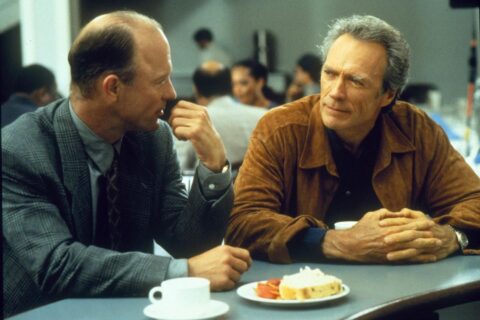Clint Eastwood is not a fan of authority. He might be known in the popular press by that time he talked to a chair at a republican conference, but in his films at least, all authority is prodded and questioned in favour of an intense libertarian standpoint. Every administration gets the critique they deserve. In his self-directed Absolute Power — a paranoid-fantasy directly aimed at the lecherous corruption of the Clinton administration and the Lewinsky affair — he is an old jewel thief who accidentally stumbles upon the President (Gene Hackman, channelling evil) initiating sex with a young woman.
There’s a two-way mirror. Eastwood can see them. They can’t see him. Eastwood loves to shoot his films with minimal lighting, a deep black enveloping his body, his face pulling all kinds of disgusted gestures at the sex turning ugly, fast. She tries to kill the president with a letter-opener. The Secret Service jump in and shoot her straight away. It’s another conspiracy, and only one man knows the truth!
I was inspired to watch this after Murder at 1600 (Dwight H. Little, 1997), which couldn’t use the Dave (Ivan Reitman, 1993) set of the White House, used here, and built their own in Toronto. I was curious how different the White House would look (much less ornate here) and how Clint Eastwood would play around with presidential privilege and the extrajudicial darkness at the heart of the secret service.
Adapted by the poorly-received novel by David Baldacci — very much the definition of an airport read — Clint Eastwood chooses to explore his pet theme here; absent, stoic fathers, roping in the ever-reliable Laura Linney to play his daughter. Combined with Ed Harris as a cop who respects Eastwood more than the president, and this four-hander moves in strange, mysterious ways, angling further towards character-study than genuine action thrills.
There’s a fantastic, Heat-inspired (Michael Mann, 1995) moment where Harris and Eastwood sit in a museum cafeteria and discuss elements of the case, circling around each other to see where the angle is. Later moments of pathos are simple conversations between Eastwood and Linney, the case allowing them to connect in ways they never had before. All the while, Eastwood’s minimalist set-ups and spare character construction give it a lean feel despite the two-hour plus runtime.
Anti-climactic to a fault, I imagine audiences were perplexed by the fascinating way Eastwood inverted such a pulpy premise. But perhaps the best rebellion against all-seeing, all-knowing state, is to stress our unique presence on this earth, showing not just one man out-witting the government, but out-humanising them too.

Redmond is the editor-in-chief of Journey Into Cinema.
